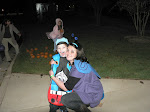All Souls Day
All Soul's Day (sometimes called the "Day of the Dead") is always November 2 (November 3rd if the 2nd falls on a Sunday).
All Soul's Day is a Roman Catholic day of remembrance for friends and loved ones who have passed away. This comes from the ancient Pagan Festival of the Dead, which celebrated the Pagan belief that the souls of the dead would return for a meal with the family. Candles in the window would guide the souls back home, and another place was set at the table. Children would come through the village, asking for food to be offered symbolically to the dead, then donated to feed the hungry.
The day purposely follows All Saint's Day in order to shift the focus from those in heaven to those in purgatory. It is celebrated with masses and festivities in honor of the dead. While the Feast of All Saints is a day to remember the glories of Heaven and those there, the Feast of All Souls reminds us of our obligations to live holy lives and that there will be purification of the souls of those destined for Heaven.
The Christian holiday of All Soul's Day pays respect and remembers the souls of all friends and loved ones who have died and gone to heaven. The living pray on behalf of Christians who are in purgatory, the state in the afterlife where souls are purified before proceeding to heaven. Souls in purgatory, who are members of the church just like living Christians, must suffer so that they can be purged of their sins. It is a time to pray for their souls that they may be received into heaven.
Upon death, it is believed that souls have not yet been cleansed of sin. Praying for souls of loved ones helps to remove the stain of sin, and allow the souls to enter the pearly gates of heaven. Through prayer and good works, living members of the church may help their departed friends and family. There are three Requiem Masses that are said by the clergy to assist the souls from Purgatory to Heaven: one for the celebrant, one for the departed, and one for the pope.
The traditions of the Feast of All Souls began independently of the Feast of All Saints. The Feast of All Souls owes its beginning to seventh century monks who decided to offer the mass on the day after Pentecost for their deceased community members. In the late tenth century, the Benedictine monastery in Cluny chose to move their mass for their dead to November 2, the day after the Feast of all Saints. This custom spread and in the thirteenth century, Rome put the feast on the calendar of the entire Church. The date remained November 2 so that all in the Communion of the Saints might be celebrated together.
Many customs are associated with The Day of the Dead celebration. In the home an altar is made with an offering of food upon it. It is believed that the dead partake of the food in spirit and the living eat it later. The ofrendas (offerings) are beautifully arranged with flowers such as marigolds (zempasuchitl), which are the traditional flower of the dead. There is a candle placed for each dead soul, and they are adorned in some manner. Incense is also often used, and mementos, photos, and other remembrances of the dead also adorn the ofrenda.
It is also traditional in some areas to see the play Don Juan Tenorio. Paper mache and sugar skulls are popular, as are cardboard coffins from which a skeleton can be made to jump out. Special masks are also worn, allowing a person to achieve a facial expression for which they feel they are inadequate to achieve.
Traditional Catholics still honor customs related to the relief of the souls suffering in purgatory. One custom is for persons to pray six Our Fathers, Hail Mary's and Glory Be's for the intentions of the Pope in a church, and thereby, receive a plenary indulgence for a soul in purgatory. This action may be repeated for another soul, by leaving the church and re-entering it to repeat the prayers.
All Soul's Day lives on today, particularly in Mexico, where All Hallows' Eve, All Saint's Day and All Soul's Day are collectively observed as "Los Dias de los Muertos" (The Days of the Dead). First and foremost, the Days of the Dead is a time when families fondly remember the deceased. But it is also a time marked by festivities, including spectacular parades of skeletons and ghouls. In one notable tradition, revelers lead a mock funeral procession with a live person inside a coffin.
Tagging Along
1 month ago






No comments:
Post a Comment